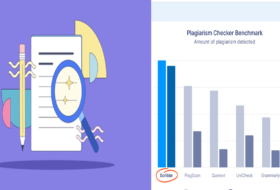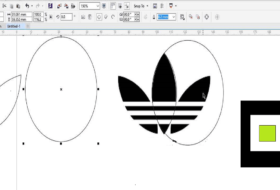Summary of Article
Why is creativity important in business, education, science, and all works of life? From the conception of man till his exit on earth, man has been in continuous competition. It takes creativity for man to distinguish himself in this competitive cycle. In a nutshell, this article gave insights to the following:
- Creativity is the art of finding new ways of solving persistent problems. It is also, a process of bringing your imagination into reality.
- The creative process begins with people and ends with people. Creative skills involve mastering design thinking, innovation, collaboration, and preferring solutions to people’s needs.
- Creativity is gradually influencing worldwide educational policy to meet with the skills of the future workforce. Businesses, industries, institutions, and the government will rely on creativity to maintain a competitive advantage in the future.
- Children are more creative than adults. There is a decreasing creative behavior in children as they begin to age. Hence, creative education is better at the elementary level. Also, if we must build a culture of creativity in our children, we must start before the age of 10.
- There are four domains of creativity, namely: cognitive, emotional, deliberate and spontaneous. These domain form a matrix of types of creativity known as: deliberate and cognitive, deliberate and emotional, spontaneous and cognitive, and spontaneous and emotional creativity.
- These types of creativity are traits of creative behaviour classified as: problem-solving self, implementing self, idea-sensing self, and idea-finding self respectively.
- Land discovered that for one to be creative, two thinking processes are involved: convergent and divergent thinking. Convergent involves refinement and improvement of ideas, while in divergent, imagination and originality of idea is key.
- Through creative thinking, one can develop a new business model to drive sales of products and services, create new employment markets to absorb the unemployed, and closeup the skill gap in the job market.
- There are major reasons why creativity is important: creativity activates the mind for unknown possibilities; opens unseen opportunities in different sectors, refines existing ideas for better solution, and enhances decision making.
- Creativity can be learned, therefore anyone can become creative by doing the following: engaging in divergent thinking, learning the 3-dimensional act of creativity, and mastering the 5-model of creativity. You can also discover your area of intellectual advantage, and collaborate with others.
Why is creativity important in life? Does creativity has any relationship with education? The concept of creativity is not new, but it has been constantly neglected by the education system. Could it be that the traditional education system does not know why creativity is important for the future.
But why is creativity important for children, educators, and the modern workplace? In this article, we will answer the question: why is creativity important now and for the future. Before we get there, lets first define the term creativity.
What is Creativity?
Creativity definition can come in different forms as conceived by different people, but all points to the same parameters. Let’s look at a few of these definitions:
“Creativity is the tendency to generate ideas, alternatives, or possibilities that may be useful in solving problems, communicating with others, and entertaining ourselves and others.” Similarly, “it is the act of turning new and imaginative ideas into reality.”
According to James Clear, the creative process involves making new connections with old ideas and recognizing the relationships between them. James looked at creative thinking as a concept that allows people to combine old pieces of ideas into new formations.
Looking at the few definitions above, we realize that all point to the same parameters, as illustrated in the picture below.
Thus, I can simply say that creativity is the art of finding new ways of solving persistent problems. It is also, a process of bringing your imagination into reality.

Definition of creativity
The illustration states that the creative process begins with people and ends with people. Creative skills involve mastering design thinking, innovation, collaboration, and preferring solutions to people’s needs.
The Creative Paradox
Can creativity be learned?
Creativity can be learned but we can also grow while developing the creative genius within us. Every child is born a creative genius, and children are more creative than adults, because to them, everything is possible. At a tender age, the mind and thought patterns of children are better framed to iterate solutions to impending problems. Also, they utilize the full power of the brain without fear and criticism.
This I believe happens because they are not yet accustomed to our traditional education system. Rebecca Weicht believes that our traditional educational system dumps our creative genius within us because it does not value innovation and entrepreneurial thinking.
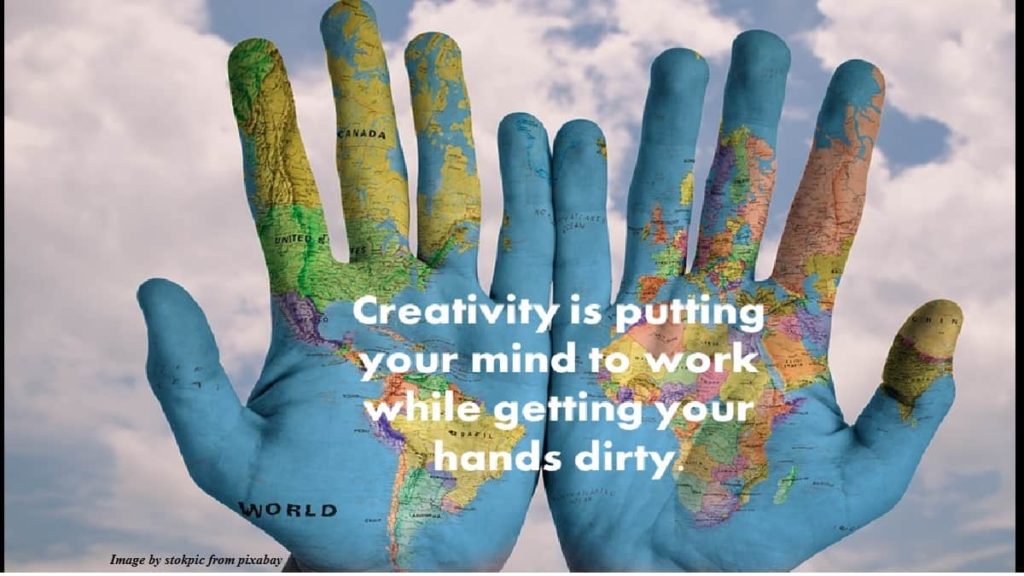
Creativity is putting your mind to work while getting your hands dirty. Your mind does not need to be dirty and corrupt but should be as pure as light, like that of a child. This is because creativity aims at improving human existence rather than destroying lives.
Creativity in children might be high because they have not yet learned the customs and traditions, and dos and don’ts of the society. As a result, they can easily think out solutions without considering its implications to society.
Their way of thinking conforms with the saying of Ralph Waldo Emerson: “He who would be a man must deviate from existing standards.” This might be difficult for adults, but easy for children. Because at their stage, they are not yet accustomed to set standards.
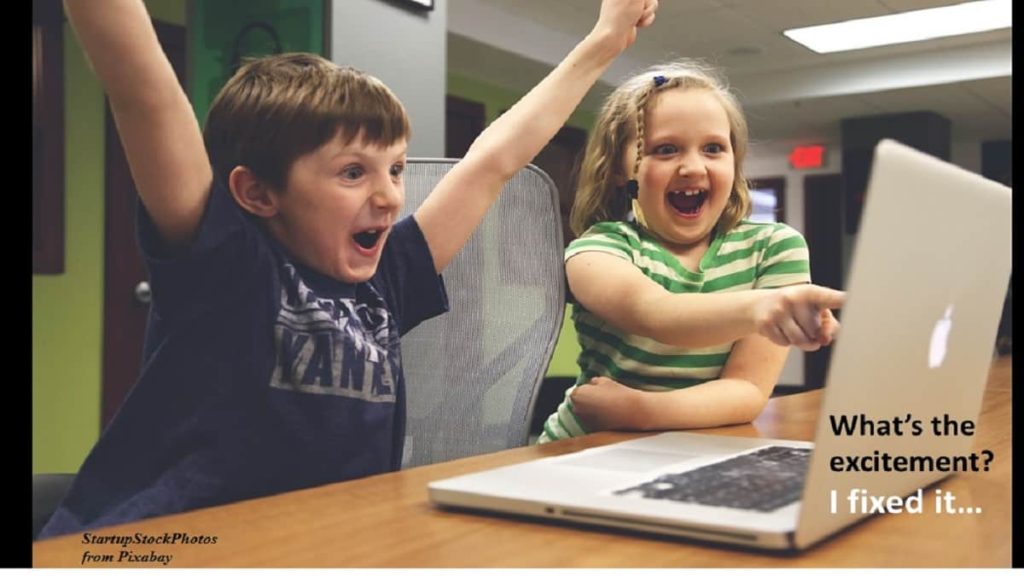
Effect of traditional education
Over time, the creative genius in children begins to drop. This according to George Land is due to the industrial revolution. He believed that the industrial revolution led educators to develop schools (‘factories’) that manufacture people that could work in the factories.
Due to the negative effect of education and aging on creativity, we must destroy or neglect laid down rules, if we want to be creative. To be creative, we must neglect popular opinions and direct our goal to the results. According to Jack Kerouac, “Great things are not accomplished by those who yield to trends and fads and popular opinion.”
Why is creativity important to education?
You can agree with me that the traditional system of education has destroyed creativity. This is a fact for the traditional system of education but not for the modern system.
Teaching and learning in the 21st century are gradually transforming from traditional education to creative education. Creativity is gradually influencing worldwide educational policy to meet with the skills of the future workforce. Businesses, industries, institutions, and the government will rely on creativity to maintain a competitive advantage in the future. Hence, the understanding of creativity will help us shape our future and that of our children.
Albert Einstein once said; “It is the supreme art of the teacher to awaken joy in creative expression and knowledge”. This statement is also true for the parents and guardians.
George Land’s Discovery
The statement that children are more creative than adults is not a mere saying. It is backed up by research conducted in 1968 by George Land. According to the study, the creative ability of 1600 children was tested. These children were tested at ages 5, 10, and 15 years. The same children when tested at these different ages, revealed astonishing results as follow:
- When at 5 years, 98% of these children were found to be creative.
- After the children were 10 years, it was discovered that only 30% of them were creative.
- When the children were 15 years, the study revealed that only 12% of them were creative.
- Finally, it was discovered that only 2% of adults, with an average age of 31 years, were creative.
Let’s look at the results at a glance.
| Ages | Years added | Creativity level | Loss of creativity | Cumulative loss | Remark |
| 5 years | 0 | 98% | 2% | 2% | Decrease |
| 10 years | 5 | 30% | 68% | 70% | Decrease |
| 15 | 5 | 12% | 18% | 88% | Decrease |
| 31 | 16 | 2% | 10% | 98% | Decrease |
From the table, it means that some children are 98% more creative than many adults. Also, after the age of 10 years, children tend to become less creative. The highest percentage loss of creativity occurs at the age of 10. From the perspective of education, we understand that at this age, many children begin their junior secondary education. This could be a good reason for the loss of creativity.
In general, there is a decreasing creative behavior in children as they begin to age. Hence, creative education is better at the elementary level. Also, if we must build a culture of creativity in our children, we must start before the age of 10.
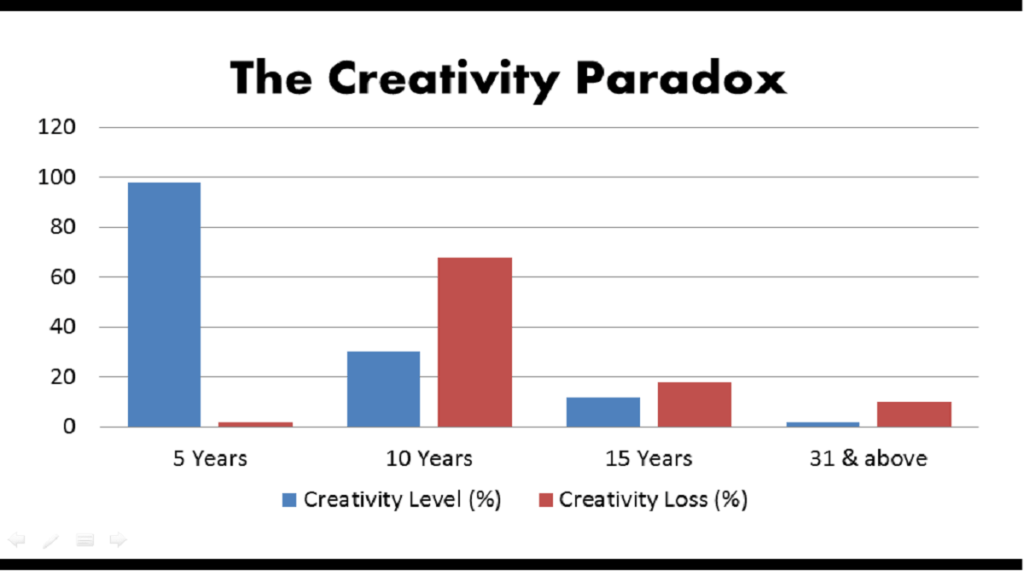
The Creativity Paradox
This discovery might seem shocking, but it is a fact. It shows that we tend to lose our creative ability as we age. And this can be worsened by the absence of creative education.
Types of Creativity
According to Arne Dietrich, there are four distinct processing modes of creativity, namely:
- Cognitive
- Emotional
- Deliberate , and
- Spontaneous
These four domains were combined in a creative matrix to create the four (4) types of creativity, namely:
- Deliberate and cognitive
- Deliberate and emotional
- Spontaneous and cognitive
- Spontaneous and emotional
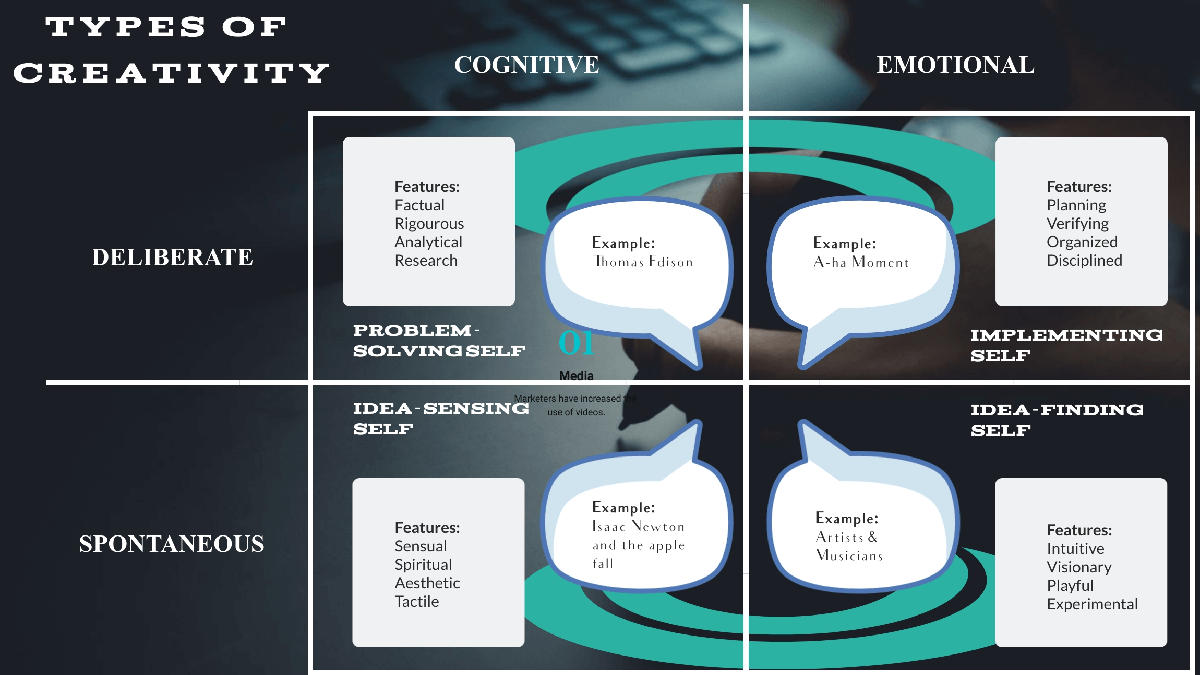
Deliberate and cognitive creative type
People in this quadrant are called the problem-solving self. They utilize fact-based and analytical thinking to solve problems. They capitalize on the knowledge and skill they have on the subject to create solution to the problem. They first define the problem and the opportunity associated with it. A typical example is Thomas Edison.
Deliberate and emotional creativity
This category is also called the implementing-self. They prefer to have quiet time, and use logical and rational thinking to find solutions. People in this category utilize discipline and organized thinking with moments of emotional reflections. It is a creative stage of turning ideas into actionable solutions, especially, when there is sudden insight into a problem. An example is a time when you will suddenly find solution, and say, ‘a-ha’.
Spontaneous and cognitive
This category is also known as the idea-sensing self. This is when the subconscious mind goes to work to finding a non-deliberate solution to a problem. You might have consciously sought for solution but could not find, on relaxing, you will unconsciously see one. This category involves expressive and tactile thinking, for example: Isaac Newton and the apple fall.
Spontaneous and emotional creativity
Also known as the idea-finding self. Creativity in this category happen at rare moments, at these moments you can use magic-wand thinking to unveil crazy ideas. This type of creativity involves intuitive and experimental thinking. An example can be found among artists and musicians.
The Thinking Process
If we must be creative as adults, we must think like children. According to Land, there are two types of thinking processes involved in creativity, namely convergent and divergent thinking. Both affect creativity to a large extent.
Convergent thinking
Convergent thinking involves criticism, a judgment of ideas, refinement of ideas, and improvement of ideas. In order words in convergent thinking, one comes up with one good idea, which has been probably refined. This form of thinking occurs in the conscious mind and involves the combination of different kinds of thoughts.
Divergent thinking
Divergent thinking comprises imagination. This is subjective and brings originality, however, it is difficult and rough to come by. This form of thinking takes place in the subconscious mind. When utilizing this kind of thinking, one comes up with multiple ideas or solutions to a problem.

Land and the thinking process
Land noted that contemporary education teaches children to use both kinds of thinking at the same time. This he suggests is destructive, because it brings conflict and competition in the brain.
I believe this will eventually lead to a loss of creativity as one age. This may be the reason those who had less formal education are more creative than those who are more educated. (Consider people like Thomas Edison, Bill Gates, and more).
Land added that, in formal education, children are often judged, criticized, and censored. And this usually leads to neurons in the brain fighting each other and eventually diminishes the power of the brain. He noted that creative thinking lights up the brain while people who operate under fear use less brainpower.
According to George Land, it is better to allow children to split their thinking processes into different states. He believed that this will make them more effective in learning.
Moreover, to make children retain their creative ability as they age, we ought to encourage them. We must allow them to express themselves and their ideas in speech and art. Our duty would be to help them evaluate and choose the best possible ideas.
Why is Creativity Important?
The importance of creativity in human endeavor cannot be overemphasized. Creativity is important in education, science, technology, business, music and arts, and government. In general, we will summarize why is creativity important in the following three subheadings.
Creativity activates the mind for unknown possibilities
Developing the creative genius within entails consistent practice and innovative thinking in divergent ways. Through creative thinking, one can develop a new business model to drive sales of products and services, create new employment markets to absorb the unemployed, and closeup the skill gap in the job market.
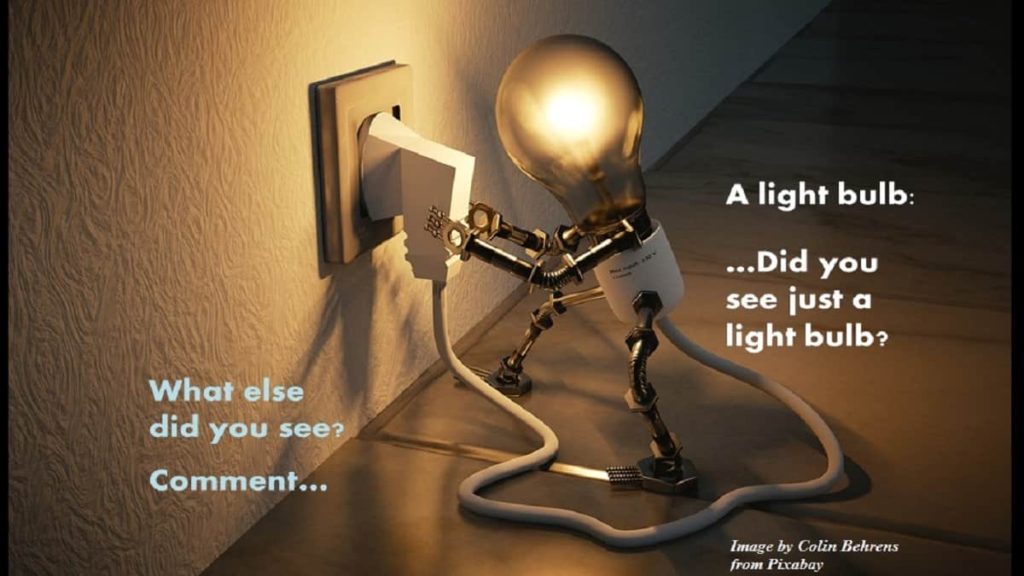
Examples of businesses where creativity abounds include music, art, interior design, product design, and interior decoration. These sectors bring out the best in people as they strive to outperform their contemporaries.
So, why is creativity important to your business? Some people who are competing in the same industry has carved out a niche for themselves through creativity. When you are faced with difficulties, it is creativity that can bail you out and showcase you to the world.
It opens unseen opportunities in different sectors
Creativity opens a wide range of opportunities in different sectors, both for graduates and non-graduates. When someone utilizes the divergent thinking process, s/he can discover what others have not been able to see in a sector.
According to Diana Celella, Founding Director of The Drawing Room & President of SBID: “My advice to a young graduate would be to listen and learn from experienced designers. To be successful in the creative industries you have to be passionate about design, it is more than a job, it is all-encompassing. You need to live, love, and breathe design.”
When one is conscious of creativity, s/he distinguishes her/himself from the crowd within the sector. Diana says, you live, love, and breathe ‘creativity’. This is what will sustain you in the longrun.
It enhances decision making
In politics, creativity can help bring the government closer to the people and ease the decision-making process. It will enhance the mindset to generate new ideas for solving persistent problems to develop solutions and implement them effectively.
The government has the capacity to employ experts and professionals to assist in decision making. This throws creativity open to such a group of people. Also, every group of persons that distinguishes themselves in works of arts and culture.
Also, in organizations, businesses and institutions, creativity will always surface when there is need to solve a problem. This is why organizations recruit people with creative potentials.
How to Become a Creative Genius
Creativity entails creative thinking, and research has shown that we are born creative. The popular question now is, how do we release this genius within?
Engage in divergent thinking
Creativity is an inward desire to be better at something. It is the freedom to enshrine flexibility in your work. You cannot be or develop the skill you never desired.
We have already discussed the two common types of thinking – convergent and divergent thinking. From our discussion, we understand that creativity requires divergent thinking. This means to be creative, you must be a divergent thinker. You must generate multiple ideas or solutions when faced with a problem.
Learn the 3-dimensional act of creativity
According to Robert Sternberg creativity is three-dimensional, namely analytical, creative, and practical. He believed that creativity is a collaboration of experiences and adaptations. He looked at intelligence in relation to the individual’s approach to dealing with challenges.

He said that analytical intelligence refers to an individual’s ability to dissect problems and come up with possible solutions. Creative intelligence is an individual’s ability to deal with new problems using previous experience and skills. While practical intelligence refers to an individual’s ability to adapt to the changing world using practical experience.
This implies that to be creative, you must see new dimensions to a problem, generate ideas based on experience for solving the problem. Also, you must not be static. With your experience, you have to adapt to changes within your environment.
Master the 5-model of creativity
With her colleagues at the Centre for Real-World Learning, Bill Lucas developed a five-model of creativity that can help in our creative journey. This model displayed below involves imagination, inquisition, persistence, collaboration, and discipline.
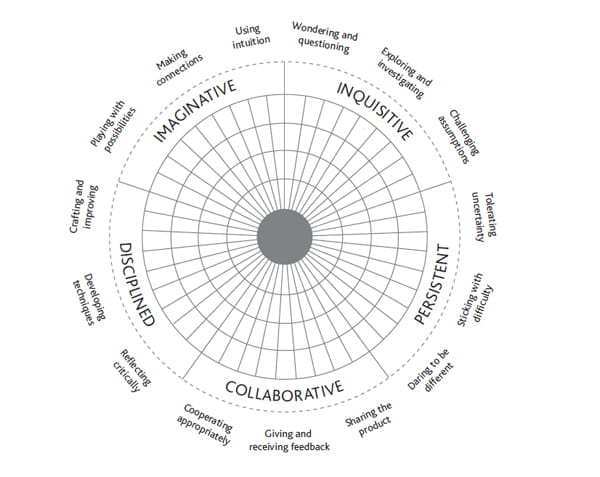
Imagination involves the ability to bring imaginative solutions and possibilities to problems. It involves the use of intuition, playing and manipulating with possibilities, and connecting possibilities together.
Inquisition is one’s ability to engage his/her creative mind in asking worthwhile questions on a problem or topic. It involves wondering and questioning that generates new ideas that bring a solution. Creativity in inquisition also involves exploring, investigating, and acting on ideas that follow the questions asked. Finally, inquisition makes one to critically examine and challenge existing assumptions. Things are not taking as seen without convincing answers.
Persistence is the act of not giving up easily. Creativity builds tenacity in individuals, even in times of difficulty. Persistence breeds self-confidence and the ability to tolerate uncertainty when pursuing goals.
Collaboration is the act of recognizing the social dimension of creativity. Collaboration involves the sharing of creative products, giving and receiving feedback, and cooperating appropriately with others.
Discipline helps the creative individual to develop expertise in the creative process. Discipline involves constant practice to develop techniques and skills, critically reflecting and evaluating ideas and crafting and improving one’s skills.
Discover your area of intellectual advantage
Finally, Howard Gardner developed a theory of multiple intelligence which he used to analyze an individual’s intellectual abilities. According to Gardner, an individual’s intelligence can be divided into eight types, which are based on specific skills. They include verbal, mathematical, spatial, bodily-kinesthetic, musical, interpersonal, intrapersonal, and naturalistic.
Anyone willing to develop creative thinking and become creative should develop the core characteristics within each of these models.
Collaborate with others
The Conversation disclosed that creativity can also be fostered by connecting students with other cultures, groups, and organizations – both locally and globally. This could include connecting with schools and communities from around the world, understanding how to improve the environment, how new technology is being used to improve healthcare, how local farmers play a part in food production, or how new films and TV series are made.
Conclusion
In this era of self-driving cars, electric-powered cars, reusable rockets, robotics, and artificial intelligence, should we still rely on the system of education set up to enlighten the workforce of colonial masters? Should we trap the creative genius in us or in our children, which are crying for expression?
Being creative gives you more control. Control over your problems and that of others. When you have control over people’s problems, you can easily command their wallets.
Control will also give you more confidence even when a solution is not forthcoming. We must not leave this journey of creativity to a privileged few. We all should be part of the solution. Our children and children-children should be part of the solution.
How old are you? Are you gradually aging? The good news is that there is still a way out. That creative genius still lies within. Though aging has taken a reasonable portion of your creative genius, you can still turn it on. How can you do this?
Land suggested that you look inwards. Remember all those dreams when you were still young. Do you still think that it is impossible? It is time for you to challenge yourself. Do not be fixated on one solution. Come up with different ideas that will help you solve a particular problem.
Ken Robinson said, “If you’re not prepared to be wrong, you’ll never come up with anything original.” Creativity is not rigid. That is why George Land said, “Tomorrow, you take a table fork, turn your five-year-old on and come up with 25 or 30 ideas on how to improve on the table fork.”
Therefore, we must encourage creative education at all levels. Do not underestimate your ability; do not underestimate the ability of someone either. We all are equal to the task. Let’s Begin this Journey today with your thoughts!
What is your idea of creativity?


